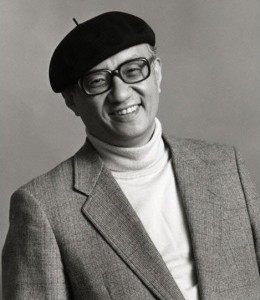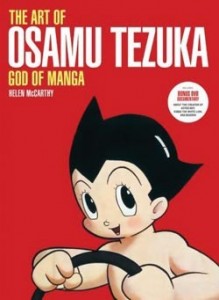When Khursten Santos announced that this month’s Manga Movable Feast would be… well, a feast, that provided me with a swell excuse to highlight my favorite food manga. I attribute my interest in the genre to my brief but intense infatuation with Iron Chef in the mid-2000s. I had always found cooking shows uninteresting: why watch someone make a cake or a roast when I already knew how to do that? Iron Chef, however, reimagined the cooking show as a tournament manga with an identifiable cast of characters who faced new and increasingly difficult challenges each week. Presiding over the competition was a flamboyant “villain” — the one and only Chairman Kaga — who was capricious and extravagant, demanding his contestants turn asparagus and ayu into ice cream and amuse-bouche. I can’t say I learned how to prepare any dishes from watching Iron Chef, but I came to appreciate the Iron Chefs’ creativity and combat-readiness.
When I discovered that there were manga that looked and sounded like an episode of Iron Chef, I was ecstatic. I read Iron Wok Jan and Yakitate!! Japan before discovering more sedate forms of food manga: Antique Bakery, Kitchen Princess, Mixed Vegetables. I gradually lost interest in the melodramatic pageantry of Iron Chef, but not in Japanese cuisine. I’ve been expanding my culinary horizons through manga instead, tackling anything with a food theme. Which ones reign supreme in Manga Critic Stadium? Read on for the list!
 7. EKIBEN HITORITABI
7. EKIBEN HITORITABI
KAN SAKURAI AND JUN HAYASE • JMANGA • 2 VOLUMES (ONGOING)
If you need definitive proof that there’s a manga for every conceivable niche audience, look no further than Ekiben Hitoritabi, a charming series about a train bento enthusiast. Yes, you read that right: Ekiben Hitoritabi follows the exploits of Daisuke Nakahara, a thirty-five-year-old man whose greatest ambition is to sample the boxed lunches served at train stations around Japan. The story is as relaxed and meandering as Daisuke’s journey, as he transfers from one line to the next in search of the country’s best — and most exotic — ekiben. Slight as the story may be, the authors’ meticulous attention to detail and obvious fondness for train travel carry the day, making this manga both fun and educational. Now if only Amtrak would investigate ekiben… I’d take a fish cake over microwave pizza any day.
 6. NEKO RAMEN
6. NEKO RAMEN
KENJI SONISHI • TOKYOPOP • 4 VOLUMES (INCOMPLETE)
If you’ve ever lived with a cat or dog, you know that no meal is complete without a pet hair garnish. Now imagine that your beloved companion actually prepared your meals instead of watching you eat them: what sort of unimaginable horrors might you encounter beyond the stray hair? That’s the starting point for Neko Ramen, a 4-koma manga about a cat whose big dream is to run a noodle shop, but author Kenji Sonishi quickly moves past hair balls and litter box jokes to mine a richer vein of humor, poking fun at his cat cook’s delusions of entrepreneurial grandeur. Taisho is the Don Quixote of ramen vendors, dreaming up ludicrous giveaways and unappetizing dishes in an effort to promote his business, never realizing that he is the store’s real selling point. The loose, sketchy artwork gives the series an improvisational feel, while the script has the pleasant, absurdist zing of an Abbott and Costello routine. (Reviewed at The Manga Critic on 6/2/10.)
 5. YAKITATE!! JAPAN
5. YAKITATE!! JAPAN
TAKAHASHI HASHIGUCHI • VIZ MEDIA • 26 VOLUMES (COMPLETE)
Kazuma Azuma is a boy with a dream: to create a bread so beloved by the Japanese people that it becomes synonymous with the country itself. Though he lacks formal training, he’s a prodigy in the kitchen, blessed with “hands of the sun” (a.k.a. hands warm enough to jump-start the dough’s rising) and a jazz musician’s knack for improvisation. These skills land him at the modest South Tokyo branch of Pantasia, a popular chain of bakeries. There, alongside the loud-mouthed apprentice Kyosuke Kawachi, the cute but steely manager Tsukino Asuzagawa, and the bread master Ken Matsushiro, he hones his craft, develops new Ja-pan prototypes, and enters countless bake-offs. (In other words, Yakitate!! Japan is One Piece with pastry.) The series does, at times, sag under the weight of repetition — how many death-defying baking competitions can one boy win? — but its mouth-watering concoctions, colorful cast, and impromptu science lessons ensure that every volume has a least one or two outstanding chapters. (Reviewed at PopCultureShock on 3/7/07)
 4. KODOKO NO GOURMET
4. KODOKO NO GOURMET
MASAYUKI QUSUMI AND JIRO TANIGUCHI • JMANGA • 1 VOLUME (COMPLETE)
If you’re a fan of Kingyo Used Books, you may remember the chapter in which Japanese backpackers shared a dog-eared copy of Kodoku no Gourmet (a.k.a. The Lonely Gourmet) in order to feel more connected to home. Small wonder they adored Gourmet: its hero, Goro Inoshigara, is a traveler who devotes considerable time and energy to seeking out his favorite foods wherever he goes. While the manga is episodic — Goro visits a new restaurant in every chapter — Jiro Taniguchi does a wonderful job of conveying the social aspect of eating, creating brief but vivid portraits of each establishment: its clientele, its proprietors, and, of course, its signature dishes. Best of all, Taniguchi and writer Masayuki Qusumi have the good sense to limit the story to a single volume, allowing the reader to savor Goro’s culinary adventures, rather than ponder its very slight premise.
 3. GOKUDOU MESHI
3. GOKUDOU MESHI
SHIGERU TSUCHIYAMA • JMANGA • 2 VOLUMES (ONGOING)
Gokudou Meshi revolves around a contest: once a year, the residents of Naniwa South Prison describe the best food they’ve ever eaten. The prisoner with the most mouth-watering story wins an item from each of his fellow inmates’ osechi, a special New Year’s Eve box filled with fish, rice cakes, omelettes, and other holiday treats. As one might expect from such a conversation-driven series, Gokudou Meshi is told primarily through flashbacks, with each prisoner recounting a memorable meal or favorite noodle shop. Such an improbable premise lends itself to sitcom exaggeration, but author Shigeru Tsuchiyama plays it straight, respecting the sincerity of his thugs’ culinary convictions. The results read like cross between a Damon Runyon story and a Food Network Show; one could almost imagine Nicely-Nicely Johnson waxing poetic with the Naniwa gang about the hot dogs at Saratoga.
 2. NOT LOVE BUT DELICIOUS FOODS MAKE ME SO HAPPY!
2. NOT LOVE BUT DELICIOUS FOODS MAKE ME SO HAPPY!
FUMI YOSHINAGA • YEN PRESS • 1 VOLUME (COMPLETE)
My Dinner With Fumi: that’s what I would have called the English-language edition of Not Love But Delicious Foods Make Me So Happy! The fifteen stories contained within this slim volume celebrate good food and good conversation, documenting Yoshinaga’s interactions with friends, assistants, and fellow artists at real restaurants around Tokyo. No culinary stone goes unturned, as Yoshinaga — or, as her fictional alter ego is called, Y-naga — visits a Korean restaurant, a French bistro, an Italian trattoria, a sushi joint, an all-you-can-eat dim sum buffet, and a bakery famous for its bagels. As the characters chatter enthusiastically about what they’re eating, we realize that Yoshinaga’s real objective is showing us the important role that food plays in fostering friendships. One contentious conversation even prompts the omniscient narrator to praise good food for its diplomatic value: “But through the power of skirt steak, their hearts resumed beating as one,” the narrator observes. In Yoshinaga’s world, detente is just a dish away. (Reviewed at The Manga Critic on 12/12/10.)
 1. OISHINBO A LA CARTE
1. OISHINBO A LA CARTE
TETSU KARIYA AND AKIRA HANASAKI • VIZ MEDIA • 8 VOLUMES (COMPLETE)
Equal parts Iron Wok Jan, Mostly Martha, and The Manga Cookbook, this educational, entertaining series explores Japanese cuisine at its most refined — sake, seabream sashimi — and its most basic — rice, pub food. The stories fall into two categories: stories celebrating the important role of food in creating community, and stories celebrating the culinary expertise of its principal characters, newspaperman Yamaoka Shiro and his curmudgeonly father Kaibara Yuzan. (Fun fact: Yuzan is such a food snob that he drove Yamaoka’s mother to an early grave, causing an irreparable break between father and son.) Though the competition between Yamaoka and Yuzan yields some elegant, mouth-watering dishes, Oishinbo is at its best when it focuses on everyday food in everyday settings, shedding light on how the Japanese prepare everything from bean sprouts to ramen. Warning: never read on an empty stomach!
* * * * *
So, hungry readers, which food manga are your favorites? Are there food manga you’d like to see translated into English (e.g. Cooking Papa)? Dish away!
































 First published in 1964, Harriet the Spy featured a radically different kind of heroine than the sweet, obedient girls found in most mid-century juvenile lit; Harriet was bossy, self-centered, and confident, with a flair for self-dramatization and a foul mouth. She favored fake glasses, blue jeans, and a “spy tool” belt over angora sweaters or skirts, and she roamed the streets of Manhattan doing the kind of reckless, bold things that were supposed to be off-limits to girls: peering through skylights, hiding in alleys, concealing herself in dumbwaiters, filling her notebooks with scathing observations about classmates and neighbors. Perhaps the most original aspect of Louise Fitzhugh’s character was Harriet’s complete and utter commitment to the idea of being a writer; unlike Nancy Drew, Harriet wasn’t a goody-goody sleuth who wanted to help others, but a ruthless observer of human folly who viewed spying as necessary preparation for becoming an author.
First published in 1964, Harriet the Spy featured a radically different kind of heroine than the sweet, obedient girls found in most mid-century juvenile lit; Harriet was bossy, self-centered, and confident, with a flair for self-dramatization and a foul mouth. She favored fake glasses, blue jeans, and a “spy tool” belt over angora sweaters or skirts, and she roamed the streets of Manhattan doing the kind of reckless, bold things that were supposed to be off-limits to girls: peering through skylights, hiding in alleys, concealing herself in dumbwaiters, filling her notebooks with scathing observations about classmates and neighbors. Perhaps the most original aspect of Louise Fitzhugh’s character was Harriet’s complete and utter commitment to the idea of being a writer; unlike Nancy Drew, Harriet wasn’t a goody-goody sleuth who wanted to help others, but a ruthless observer of human folly who viewed spying as necessary preparation for becoming an author.